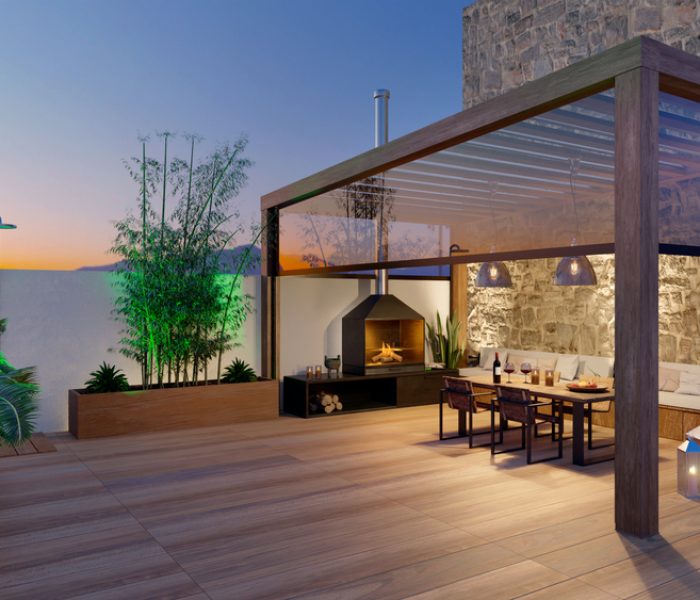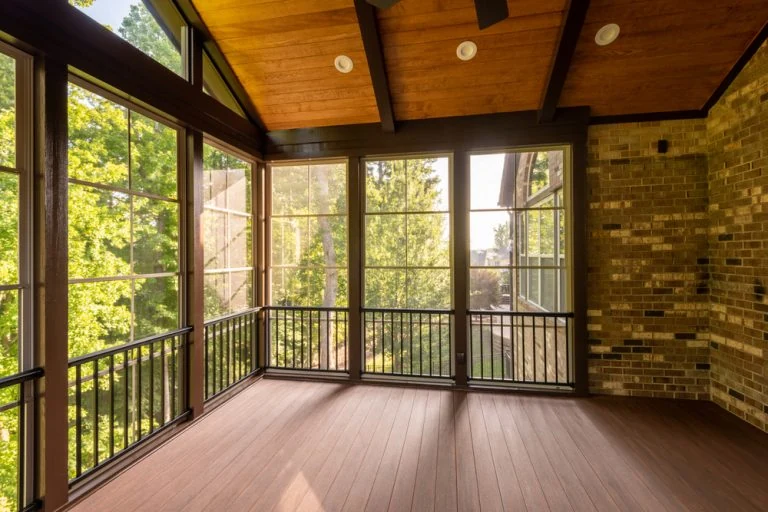
Patio Covers in Bayville, NY
Provider of Premium Sunrooms, Addition Solutions, Pergolas, LifeRoom, LifeRoom Louvered Systems, and more for all residents in Nassau County!
Get a free estimate
Awards
With our many years of experience we have earned many home remodeling awards we take pride in.




Client Testimonials
striving for great experiences

Read More
I had an exceptional experience with Four Seasons Sunrooms. They were customer satisfaction oriented and their prices were by far the most reasonable. They came out to assess my needs right away, and I had received great design advice and prompt appointments.

Read More
They are professional and friendly people who took the time to explain how the steps leading up to the completion of the sunroom and kept up with communication along the way. I would highly recommend them to any of my friends and family!

Read More
We love our new sunroom! Four Seasons worked with us to get all the necessary permits and town hearings to move forward. The workers were hard working and courteous, in very cold weather! We are enjoying our new beautiful living space.

Read More
Their products are beautiful, plus there's so many sunroom styles to choose from. I'm really impressed by the impeccable work they've done. In addition, their staff members are super friendly!
Previous
Next
Maintenance and Care for Your Patio Cover in Bayville, NY
Importance of Patio Cover Maintenance
Proper maintenance is essential to ensure the longevity and functionality of your patio cover. At Four Seasons Sunroom, we understand the significance of regular care for patio covers in Bayville, NY. Our expert team is dedicated to providing top-notch maintenance services that will keep your patio cover in excellent condition for years to come.
With a focus on customer satisfaction, we are committed to addressing any concerns you may have. Contact us at 516-253-2329 to schedule a consultation and discuss your patio cover maintenance needs in Nassau County.


Professional Patio Cover Care Services
- Inspection: At Four Seasons Sunroom, we offer comprehensive inspection services for patio covers in Bayville, NY. Our skilled technicians will assess the structural integrity of your patio cover, identifying any signs of damage or wear. If any repairs or maintenance are needed, our team will provide expert recommendations.
- Cleaning and Debris Removal: Keeping your patio cover clean is essential for its longevity. Our maintenance services in Bayville, NY include thorough cleaning and debris removal. We will ensure that dirt, leaves, and other debris are meticulously cleared, preventing potential damage and maintaining the pristine appearance of your patio cover.
- Repair and Restoration: If your patio cover requires repair or restoration work, Four Seasons Sunroom is here to help. Our experienced team is equipped to handle various issues, such as damaged panels, loose screws, or worn-out components. We will promptly address these problems and restore your patio cover to its optimal condition.
- Regular Maintenance: To ensure the ongoing functionality and aesthetics of your patio cover, regular maintenance is key. Our maintenance plans at Four Seasons Sunroom are tailored to meet the specific needs of patio covers in Bayville, NY. Our team will visit your property at predetermined intervals, conducting inspections, performing cleanings, and addressing minor repairs as necessary. Contact Four Seasons Sunroom at 516-253-2329 for expert assistance in Nassau County
Benefits of Professional Maintenance and Care
-
- Extends Lifespan: By choosing Four Seasons Sunroom for professional maintenance and care, you extend the lifespan of your patio cover in Bayville, NY. Our meticulous inspections, timely repairs, and regular maintenance help prevent small issues from becoming major problems. This saves you from costly replacements and ensures that your patio cover remains in excellent condition for years to come.
- Enhances Appearance: A well-maintained patio cover adds elegance and charm to your outdoor space. At Four Seasons Sunroom, we understand the importance of a visually appealing patio cover in Bayville, NY. Through our comprehensive cleaning and maintenance services, we preserve the beauty of your patio cover, using suitable techniques and products to ensure its long-lasting appeal.
- Preserves Functionality: Maintaining the functionality of your patio cover is crucial for an enjoyable outdoor living experience. Our skilled technicians are trained to identify and address any structural issues that may affect the performance of your patio cover in Bayville, NY. By promptly addressing loose parts, cracks, leaks, and other potential problems, we ensure your patio cover continues to offer reliable protection from the elements.
Located in the beautiful Nassau County, our maintenance and care services cater to patio covers in the area, ensuring their longevity and optimal performance. Trust Four Seasons Sunroom for expert assistance in Nassau County and experience the difference in quality patio cover maintenance.

Call Us Today!!
Bayville incorporated as a village in 1919 during the incorporated village movement which allowed many larger estate owners on Long Island to establish political and security control over their domains.
Like many other Long Island communities, Bayville was first occupied by the Matinecock Indians and was known as Oak Neck and Pine Island. In 1658, Oyster Bay resident Daniel Whitehead purchased the land from the tribes. By 1745, the land was split among 23 men, who mainly grew asparagus. In 1859, Oak Neck was renamed Bayville and the first Methodist church was constructed west of what is now Merritt Lane. Multiple estates were built in the surrounding areas, and in 1898 a drawbridge was built, connecting Bayville and Mill Neck.
In 1909, the Bayville Casino opened for business, attracting beachgoers, and in 1919, Winslow S. Pierce was elected the first mayor of the Village of Bayville. When the Arlington Hotel, Bayville Casino, and Ritzmore Estate burned to the ground, it prompted the creation of the Bayville Fire Department. Bayville was put on the front page of many newspapers in 1927 when the rum rummer William T. Bell ran ashore at the Oak Point estate. Things were a little slow for a while, but after World War II, the community began to boom. A new church, post office, and school were built in the span of three years, and from 1950 to 1960, the population doubled.
Learn more about Bayville.Useful links for Bayville, NY
Additional Links
Here are some general contractor-related links:
Albertson
Atlantic Beach
Baldwin
Baldwin Harbor
Barnum Island
Baxter Estates
Bay Park
Bayville
Bellerose
Bellerose Terrace
Bellmore
Bethpage
Brookville
Carle Place
Cedarhurst
Centre Island
Cove Neck
East Atlantic Beach
East Garden City
East Hills
East Massapequa
East Meadow
East Norwich
East Rockaway
East Williston
Elmont
Farmingdale
Floral Park
Flower Hill
Franklin Square
Freeport
Garden City
Garden City Park
Garden City South
Glen Cove
Glen Head
Glenwood Landing
Great Neck
Great Neck Estates
Great Neck Gardens
Great Neck Plaza
Greenvale
Harbor Hills
Harbor Isle
Hempstead
Herricks
Hewlett
Hewlett Bay Park
Hewlett Harbor
Hewlett Neck
Hicksville
Inwood
Island Park
Jericho
Kensington
Kings Point
Lake Success
Lakeview
Lattingtown
Laurel Hollow
Lawrence
Levittown
Lido Beach
Locust Valley
Long Beach
Lynbrook
Malverne
Malverne Park Oaks
Manhasset
Manhasset Hills
Manorhaven
Massapequa
Massapequa Park
Matinecock
Merrick
Mill Neck
Mineola
Munsey Park
Muttontown
New Cassel
New Hyde Park
North Bellmore
North Hempstead
North Hills
North Lynbrook
North Massapequa
North Merrick
North New Hyde Park
North Valley Stream
North Wantagh
Oceanside
Old Bethpage
Old Brookville
Old Westbury
Oyster Bay
Oyster Bay Cove
Plainedge
Plainview
Plandome
Plandome Heights
Plandome Manor
Point Lookout
Port Washington
Port Washington North
Rockville Centre
Roosevelt
Roslyn
Roslyn Estates
Roslyn Harbor
Roslyn Heights
Russell Gardens
Saddle Rock
Saddle Rock Estates
Salisbury
Sands Point
Sea Cliff
Seaford
Searingtown
South Farmingdale
South Floral Park
South Hempstead
South Valley Stream
Stewart Manor
Syosset
Thomaston
Uniondale
University Gardens
Upper Brookville
Valley Stream
Wantagh
West Hempstead
Westbury
Williston Park
Woodbury
Woodmere
Woodsburgh
Amagansett
Amityville
Aquebogue
Asharoken
Babylon
Baiting Hollow
Bay Shore
Bay Wood
Bayport
Belle Terre
Bellport
Blue Point
Bohemia
Brentwood
Bridgehampton
Brightwaters
Brookhaven
Calverton
Center Moriches
Centereach
Centerport
Central Islip
Cold Spring Harbor
Commack
Copiague
Coram
Cutchogue
Deer Park
Dix Hills
East Farmingdale
East Hampton
East Hampton North
East Islip
East Marion
East Moriches
East Northport
East Patchogue
East Quogue
East Setauket
East Shoreham
Eastport
Eatons Neck
Elwood
Farmingville
Fire Island
Flanders
Fort Salonga
Gilgo
Gordon Heights
Great River
Greenlawn
Greenport
Halesite
Hampton Bays
Hauppauge
Head of the Harbor
Holbrook
Holtsville
Huntington
Huntington Bay
Huntington Station
Islandia
Islip
Islip Terrace
Jamesport
Kings Park
Lake Grove
Lake Ronkonkoma
Laurel
Lindenhurst
Lloyd Harbor
Manorville
Mastic
Mastic Beach
Mattituck
Medford
Melville
Middle Island
Miller Place
Montauk
Moriches
Mount Sinai
Napeague
Nesconset
New Suffolk
Nissequogue
North Amityville
North Babylon
North Bay Shore
North Bellport
North Great River
North Haven
North Lindenhurst
North Patchogue
North Sea
Northampton
Northport
Northville
Northwest Harbor
Noyack
Oak Beach
Oakdale
Ocean Beach
Old Field
Orient
Patchogue
Peconic
Poquott
Port Jefferson
Port Jefferson Station
Quiogue
Quogue
Remsenburg
Ridge
Riverhead
Riverside
Rocky Point
Ronkonkoma
Sag Harbor
Sagaponack
Sayville
Selden
Setauket
Shelter Island
Shirley
Shoreham
Smithtown
Sound Beach
South Huntington
Southampton
Southold
Speonk
Springs
St. James
Stony Brook
Stony Brook University
Terryville
Tuckahoe
Village of the Branch
Wading River
Wainscott
Water Mill
West Babylon
West Bay Shore
West Hills
West Islip
West Sayville
Westhampton
Westhampton Beach
Wheatley Heights
Wyandanch
Yaphank
Albertson
Atlantic Beach
Baldwin
Baldwin Harbor
Barnum Island
Baxter Estates
Bay Park
Bayville
Bellerose
Bellerose Terrace
Bellmore
Bethpage
Brookville
Carle Place
Cedarhurst
Centre Island
Cove Neck
East Atlantic Beach
East Garden City
East Hills
East Massapequa
East Meadow
East Norwich
East Rockaway
East Williston
Elmont
Farmingdale
Floral Park
Flower Hill
Franklin Square
Freeport
Garden City
Garden City Park
Garden City South
Glen Cove
Glen Head
Glenwood Landing
Great Neck
Great Neck Estates
Great Neck Gardens
Great Neck Plaza
Greenvale
Harbor Hills
Harbor Isle
Hempstead
Herricks
Hewlett
Hewlett Bay Park
Hewlett Harbor
Hewlett Neck
Hicksville
Inwood
Island Park
Jericho
Kensington
Kings Point
Lake Success
Lakeview
Lattingtown
Laurel Hollow
Lawrence
Levittown
Lido Beach
Locust Valley
Long Beach
Lynbrook
Malverne
Malverne Park Oaks
Manhasset
Manhasset Hills
Manorhaven
Massapequa
Massapequa Park
Matinecock
Merrick
Mill Neck
Mineola
Munsey Park
Muttontown
New Cassel
New Hyde Park
North Bellmore
North Hempstead
North Hills
North Lynbrook
North Massapequa
North Merrick
North New Hyde Park
North Valley Stream
North Wantagh
Oceanside
Old Bethpage
Old Brookville
Old Westbury
Oyster Bay
Oyster Bay Cove
Plainedge
Plainview
Plandome
Plandome Heights
Plandome Manor
Point Lookout
Port Washington
Port Washington North
Rockville Centre
Roosevelt
Roslyn
Roslyn Estates
Roslyn Harbor
Roslyn Heights
Russell Gardens
Saddle Rock
Saddle Rock Estates
Salisbury
Sands Point
Sea Cliff
Seaford
Searingtown
South Farmingdale
South Floral Park
South Hempstead
South Valley Stream
Stewart Manor
Syosset
Thomaston
Uniondale
University Gardens
Upper Brookville
Valley Stream
Wantagh
West Hempstead
Westbury
Williston Park
Woodbury
Woodmere
Woodsburgh
Amagansett
Amityville
Aquebogue
Asharoken
Babylon
Baiting Hollow
Bay Shore
Bay Wood
Bayport
Belle Terre
Bellport
Blue Point
Bohemia
Brentwood
Bridgehampton
Brightwaters
Brookhaven
Calverton
Center Moriches
Centereach
Centerport
Central Islip
Cold Spring Harbor
Commack
Copiague
Coram
Cutchogue
Deer Park
Dix Hills
East Farmingdale
East Hampton
East Hampton North
East Islip
East Marion
East Moriches
East Northport
East Patchogue
East Quogue
East Setauket
East Shoreham
Eastport
Eatons Neck
Elwood
Farmingville
Fire Island
Flanders
Fort Salonga
Gilgo
Gordon Heights
Great River
Greenlawn
Greenport
Halesite
Hampton Bays
Hauppauge
Head of the Harbor
Holbrook
Holtsville
Huntington
Huntington Bay
Huntington Station
Islandia
Islip
Islip Terrace
Jamesport
Kings Park
Lake Grove
Lake Ronkonkoma
Laurel
Lindenhurst
Lloyd Harbor
Manorville
Mastic
Mastic Beach
Mattituck
Medford
Melville
Middle Island
Miller Place
Montauk
Moriches
Mount Sinai
Napeague
Nesconset
New Suffolk
Nissequogue
North Amityville
North Babylon
North Bay Shore
North Bellport
North Great River
North Haven
North Lindenhurst
North Patchogue
North Sea
Northampton
Northport
Northville
Northwest Harbor
Noyack
Oak Beach
Oakdale
Ocean Beach
Old Field
Orient
Patchogue
Peconic
Poquott
Port Jefferson
Port Jefferson Station
Quiogue
Quogue
Remsenburg
Ridge
Riverhead
Riverside
Rocky Point
Ronkonkoma
Sag Harbor
Sagaponack
Sayville
Selden
Setauket
Shelter Island
Shirley
Shoreham
Smithtown
Sound Beach
South Huntington
Southampton
Southold
Speonk
Springs
St. James
Stony Brook
Stony Brook University
Terryville
Tuckahoe
Village of the Branch
Wading River
Wainscott
Water Mill
West Babylon
West Bay Shore
West Hills
West Islip
West Sayville
Westhampton
Westhampton Beach
Wheatley Heights
Wyandanch
Yaphank
Albertson
Atlantic Beach
Baldwin
Baldwin Harbor
Barnum Island
Baxter Estates
Bay Park
Bayville
Bellerose
Bellerose Terrace
Bellmore
Bethpage
Brookville
Carle Place
Cedarhurst
Centre Island
Cove Neck
East Atlantic Beach
East Garden City
East Hills
East Massapequa
East Meadow
East Norwich
East Rockaway
East Williston
Elmont
Farmingdale
Floral Park
Flower Hill
Franklin Square
Freeport
Garden City
Garden City Park
Garden City South
Glen Cove
Glen Head
Glenwood Landing
Great Neck
Great Neck Estates
Great Neck Gardens
Great Neck Plaza
Greenvale
Harbor Hills
Harbor Isle
Hempstead
Herricks
Hewlett
Hewlett Bay Park
Hewlett Harbor
Hewlett Neck
Hicksville
Inwood
Island Park
Jericho
Kensington
Kings Point
Lake Success
Lakeview
Lattingtown
Laurel Hollow
Lawrence
Levittown
Lido Beach
Locust Valley
Long Beach
Lynbrook
Malverne
Malverne Park Oaks
Manhasset
Manhasset Hills
Manorhaven
Massapequa
Massapequa Park
Matinecock
Merrick
Mill Neck
Mineola
Munsey Park
Muttontown
New Cassel
New Hyde Park
North Bellmore
North Hempstead
North Hills
North Lynbrook
North Massapequa
North Merrick
North New Hyde Park
North Valley Stream
North Wantagh
Oceanside
Old Bethpage
Old Brookville
Old Westbury
Oyster Bay
Oyster Bay Cove
Plainedge
Plainview
Plandome
Plandome Heights
Plandome Manor
Point Lookout
Port Washington
Port Washington North
Rockville Centre
Roosevelt
Roslyn
Roslyn Estates
Roslyn Harbor
Roslyn Heights
Russell Gardens
Saddle Rock
Saddle Rock Estates
Salisbury
Sands Point
Sea Cliff
Seaford
Searingtown
South Farmingdale
South Floral Park
South Hempstead
South Valley Stream
Stewart Manor
Syosset
Thomaston
Uniondale
University Gardens
Upper Brookville
Valley Stream
Wantagh
West Hempstead
Westbury
Williston Park
Woodbury
Woodmere
Woodsburgh
Amagansett
Amityville
Aquebogue
Asharoken
Babylon
Baiting Hollow
Bay Shore
Bay Wood
Bayport
Belle Terre
Bellport
Blue Point
Bohemia
Brentwood
Bridgehampton
Brightwaters
Brookhaven
Calverton
Center Moriches
Centereach
Centerport
Central Islip
Cold Spring Harbor
Commack
Copiague
Coram
Cutchogue
Deer Park
Dix Hills
East Farmingdale
East Hampton
East Hampton North
East Islip
East Marion
East Moriches
East Northport
East Patchogue
East Quogue
East Setauket
East Shoreham
Eastport
Eatons Neck
Elwood
Farmingville
Fire Island
Flanders
Fort Salonga
Gilgo
Gordon Heights
Great River
Greenlawn
Greenport
Halesite
Hampton Bays
Hauppauge
Head of the Harbor
Holbrook
Holtsville
Huntington
Huntington Bay
Huntington Station
Islandia
Islip
Islip Terrace
Jamesport
Kings Park
Lake Grove
Lake Ronkonkoma
Laurel
Lindenhurst
Lloyd Harbor
Manorville
Mastic
Mastic Beach
Mattituck
Medford
Melville
Middle Island
Miller Place
Montauk
Moriches
Mount Sinai
Napeague
Nesconset
New Suffolk
Nissequogue
North Amityville
North Babylon
North Bay Shore
North Bellport
North Great River
North Haven
North Lindenhurst
North Patchogue
North Sea
Northampton
Northport
Northville
Northwest Harbor
Noyack
Oak Beach
Oakdale
Ocean Beach
Old Field
Orient
Patchogue
Peconic
Poquott
Port Jefferson
Port Jefferson Station
Quiogue
Quogue
Remsenburg
Ridge
Riverhead
Riverside
Rocky Point
Ronkonkoma
Sag Harbor
Sagaponack
Sayville
Selden
Setauket
Shelter Island
Shirley
Shoreham
Smithtown
Sound Beach
South Huntington
Southampton
Southold
Speonk
Springs
St. James
Stony Brook
Stony Brook University
Terryville
Tuckahoe
Village of the Branch
Wading River
Wainscott
Water Mill
West Babylon
West Bay Shore
West Hills
West Islip
West Sayville
Westhampton
Westhampton Beach
Wheatley Heights
Wyandanch
Yaphank
Albertson
Atlantic Beach
Baldwin
Baldwin Harbor
Barnum Island
Baxter Estates
Bay Park
Bayville
Bellerose
Bellerose Terrace
Bellmore
Bethpage
Brookville
Carle Place
Cedarhurst
Centre Island
Cove Neck
East Atlantic Beach
East Garden City
East Hills
East Massapequa
East Meadow
East Norwich
East Rockaway
East Williston
Elmont
Farmingdale
Floral Park
Flower Hill
Franklin Square
Freeport
Garden City
Garden City Park
Garden City South
Glen Cove
Glen Head
Glenwood Landing
Great Neck
Great Neck Estates
Great Neck Gardens
Great Neck Plaza
Greenvale
Harbor Hills
Harbor Isle
Hempstead
Herricks
Hewlett
Hewlett Bay Park
Hewlett Harbor
Hewlett Neck
Hicksville
Inwood
Island Park
Jericho
Kensington
Kings Point
Lake Success
Lakeview
Lattingtown
Laurel Hollow
Lawrence
Levittown
Lido Beach
Locust Valley
Long Beach
Lynbrook
Malverne
Malverne Park Oaks
Manhasset
Manhasset Hills
Manorhaven
Massapequa
Massapequa Park
Matinecock
Merrick
Mill Neck
Mineola
Munsey Park
Muttontown
New Cassel
New Hyde Park
North Bellmore
North Hempstead
North Hills
North Lynbrook
North Massapequa
North Merrick
North New Hyde Park
North Valley Stream
North Wantagh
Oceanside
Old Bethpage
Old Brookville
Old Westbury
Oyster Bay
Oyster Bay Cove
Plainedge
Plainview
Plandome
Plandome Heights
Plandome Manor
Point Lookout
Port Washington
Port Washington North
Rockville Centre
Roosevelt
Roslyn
Roslyn Estates
Roslyn Harbor
Roslyn Heights
Russell Gardens
Saddle Rock
Saddle Rock Estates
Salisbury
Sands Point
Sea Cliff
Seaford
Searingtown
South Farmingdale
South Floral Park
South Hempstead
South Valley Stream
Stewart Manor
Syosset
Thomaston
Uniondale
University Gardens
Upper Brookville
Valley Stream
Wantagh
West Hempstead
Westbury
Williston Park
Woodbury
Woodmere
Woodsburgh
Amagansett
Amityville
Aquebogue
Asharoken
Babylon
Baiting Hollow
Bay Shore
Bay Wood
Bayport
Belle Terre
Bellport
Blue Point
Bohemia
Brentwood
Bridgehampton
Brightwaters
Brookhaven
Calverton
Center Moriches
Centereach
Centerport
Central Islip
Cold Spring Harbor
Commack
Copiague
Coram
Cutchogue
Deer Park
Dix Hills
East Farmingdale
East Hampton
East Hampton North
East Islip
East Marion
East Moriches
East Northport
East Patchogue
East Quogue
East Setauket
East Shoreham
Eastport
Eatons Neck
Elwood
Farmingville
Fire Island
Flanders
Fort Salonga
Gilgo
Gordon Heights
Great River
Greenlawn
Greenport
Halesite
Hampton Bays
Hauppauge
Head of the Harbor
Holbrook
Holtsville
Huntington
Huntington Bay
Huntington Station
Islandia
Islip
Islip Terrace
Jamesport
Kings Park
Lake Grove
Lake Ronkonkoma
Laurel
Lindenhurst
Lloyd Harbor
Manorville
Mastic
Mastic Beach
Mattituck
Medford
Melville
Middle Island
Miller Place
Montauk
Moriches
Mount Sinai
Napeague
Nesconset
New Suffolk
Nissequogue
North Amityville
North Babylon
North Bay Shore
North Bellport
North Great River
North Haven
North Lindenhurst
North Patchogue
North Sea
Northampton
Northport
Northville
Northwest Harbor
Noyack
Oak Beach
Oakdale
Ocean Beach
Old Field
Orient
Patchogue
Peconic
Poquott
Port Jefferson
Port Jefferson Station
Quiogue
Quogue
Remsenburg
Ridge
Riverhead
Riverside
Rocky Point
Ronkonkoma
Sag Harbor
Sagaponack
Sayville
Selden
Setauket
Shelter Island
Shirley
Shoreham
Smithtown
Sound Beach
South Huntington
Southampton
Southold
Speonk
Springs
St. James
Stony Brook
Stony Brook University
Terryville
Tuckahoe
Village of the Branch
Wading River
Wainscott
Water Mill
West Babylon
West Bay Shore
West Hills
West Islip
West Sayville
Westhampton
Westhampton Beach
Wheatley Heights
Wyandanch
Yaphank
